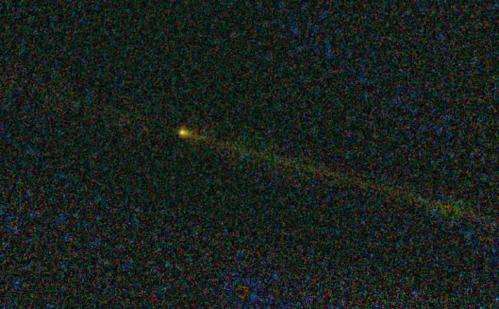Comet Hartley 2 leaves a bumpy trail

New findings from NEOWISE, the asteroid- and comet-hunting portion of NASA's Wide-field Infrared Survey Explorer mission, show that comet Hartley 2 leaves a pebbly trail as it laps the sun, dotted with grains as big as golf balls.
Previously, NASA's EPOXI mission, which flew by the comet on Nov. 4, 2010, found golf ball- to basketball-sized fluffy ice particles streaming off comet Hartley 2. NEOWISE data show that the golf ball-sized chunks survive farther away from the comet than previously known, winding up in Hartley 2's trail of debris. The NEOWISE team determined the size of these particles by looking at how far they deviated from the trail. Larger particles are less likely to be pushed away from the trail by radiation pressure from the sun.
The observations also show that the comet is still actively ejecting carbon dioxide gas at a distance of 2.3 astronomical units from the sun, which is farther away from the sun than where EPOXI detected carbon dioxide jets streaming from the comet. An astronomical unit is the average distance between Earth and the sun.
"We were surprised that carbon dioxide plays a significant role in comet Hartley 2's activity when it's farther away from the sun," said James Bauer, the lead author of a new paper on the result in the Astrophysical Journal.
JPL manages and operates the Wide-field Infrared Survey Explorer for NASA's Science Mission Directorate, Washington. The principal investigator, Edward Wright, is at UCLA. The mission was competitively selected under NASA's Explorers Program managed by the Goddard Space Flight Center, Greenbelt, Md. The science instrument was built by the Space Dynamics Laboratory, Logan, Utah, and the spacecraft was built by Ball Aerospace & Technologies Corp., Boulder, Colo. Science operations and data processing take place at the Infrared Processing and Analysis Center at the California Institute of Technology in Pasadena. Caltech manages JPL for NASA.
More information:
arxiv.org/abs/1107.2637
Abstract
We report results based on mid-infrared photometry of comet 103P/Hartley 2 taken during May 4-13, 2010 (when the comet was at a heliocentric distance of 2.3 AU, and an observer distance of 2.0 AU) by the Wide-field Infrared Survey Explorer (Wright et al. 2010). Photometry of the coma at 22 microns and data from the University of Hawaii 2.2-m telescope obtained on May 22, 2010 provide constraints on the dust particle size distribution, dlogn/dlogm, yielding power-law slope values of alpha = -0.97 +/- 0.10, steeper than that found for the inbound particle fluence during the Stardust encounter of comet 81P/Wild 2 (Green et al. 2004). The extracted nucleus signal at 12 microns is consistent with a body of average spherical radius of 0.6 +/- 0.2 km (one standard deviation), assuming a beaming parameter of 1.2. The 4.6 micron-band signal in excess of dust and nucleus reflected and thermal contributions may be attributed to carbon monoxide or carbon dioxide emission lines and provides limits and estimates of species production. Derived carbon dioxide coma production rates are 3.5(+/- 0.9) times 10^24 molecules per second. Analyses of the trail signal present in the stacked image with an effective exposure time of 158.4 seconds yields optical-depth values near 9 x 10^-10 at a delta mean anomaly of 0.2 deg trailing the comet nucleus, in both 12 and 22 {mu}m bands. A minimum chi-squared analysis of the dust trail position yields a beta-parameter value of 1.0 x10^-4, consistent with a derived mean trail-grain diameter of 1.1/{rho} cm for grains of {rho} g/cm^3 density. This leads to a total detected trail mass of at least 4 x 10^10 {rho} kg.
Provided by JPL/NASA





















